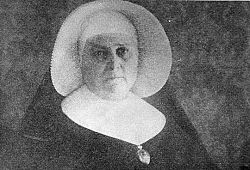A Tribute to Mother Augusta, CSC
“History does not disclose its alternatives.”
That’s a proverb that we historians often drag out. What it means is that we have no way of knowing what might have happened in a particular event if a certain factor had been added or subtracted. We historians are limited to what actually happened; everything else is speculation. (Of course that doesn’t stop us from speculating at bull sessions or cocktail parties, but we’re off duty then.)
That proverb often pops into my mind when I contemplate the history of the Congregation of the Sisters of the Holy Cross in the Diocese of Salt Lake City. They have done so very, very much that it challenges my mind to speculate what course the history of the diocese might have taken if they had declined Father (later Bishop) Lawrence Scanlan’s invitation to begin a ministry here in 1875. Priests have often been reluctant to minister here in this rural, farflung diocese in what they sometimes perceive as an unsympathetic Mormon environment. But the many religious orders who have worked here have not shrunk from the challenge, and by far the most numerous and influential of those has been the Holy Cross sisters.
The first of those was a remarkable woman named Amanda Anderson, who was born in Alexandria, Va. in 1830. When she was 4 her mother died and her father, in his grief, decided to seek a new life on the Kansas frontier. Until he could become established, he left Amanda with her aunt near Lancaster, Ohio. Her aunt was a devout Catholic who, in the absence of a nearby church, made provision in her home for traveling priests to celebrate Mass. She also enlisted Amanda to help minister to Indians on a nearby reservation, which imparted to her a lifelong missionary spirit.
At age 24 she entered the Holy Cross Congregation in Notre Dame, Ind. and took the religious name Sister Augusta. Although she was trained as a teacher, when the Civil War broke out she and two other sisters took up a nursing ministry at a military hospital in Cairo, Ill. Given the primitive nature of medicine at that time, it must have been a traumatic experience for the sisters, especially because they had no medical training.
In 1875 the young Father Scanlan, who had only been in Utah for two years himself, asked the Holy Cross sisters to consider starting a school in Salt Lake City. Sr. Augusta and Sr. Raymond Sullivan responded. Within a week they had drawn up plans for a school that would cost $25,000, and set out raising the funds. They visited every mining camp in the territory, which is where the money was at the time, and so successful were their efforts that the school opened in September 1875 with 100 pupils. It was the beginning of what became a huge ministry that eventually included several schools, Holy Cross Hospital, and St. Ann Orphanage.
Mother Augusta, as she became known, was destined for even greater things. When she returned to Notre Dame, she was named superior of the community, and then in 1889 the first Mother General of the Holy Cross Congregation in the United States.
The life and ministry of Mother Augusta should inspire us with her example of courage and compassion in the face of difficult circumstances. It also should remind us that dedicated Catholic women can have a significant role in the Church, even in places where men decline to serve.
The author gratefully acknowledges assistance from the late Bernice Maher Mooney and Sr. Genevra Rolf, CSC in preparing this article.
Gary Topping is the archivist for the Diocese of Salt Lake City.
© Copyright 2024 The Diocese of Salt Lake City. All rights reserved.



Stay Connected With Us